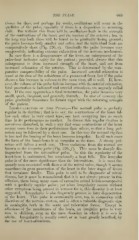Page 659 - My FlipBook
P. 659
THE PULSE. 669
timies for days, and perhaps for weeks, oscillations "will occur in the
qualities of the pulse, especially if there is a disposition to recurring
chill. But without this there will be oscillations both in the streng-th
of the contractions of the heart and the tension of the arteries ; but in
the long' run both these will be found to be gradually losing ground
;
the pulse becomes both smaller and softer, and the individual beats are
comparatively short (Fig. 370, c). Gradually the pulse becomes very
compressible, indicating extreme exhaustion of the nervous mechanism.
In case there is a chsappearance of the fever, an enlargement of the
pulse-beat indicates safety for the patient provided always that this
;
enlargement is from increased strength of the heart, and not from
increased relaxation of the arteries. This is determined by the com-
parative compressibility of the pulse. Increased arterial relaxation is
usual at the time of the subsidence of a protracted fever, but if the pulse
shows a fair increase in volume at the same time, all is well. If, how-
ever, the volume of the pulse fails to increase with the arterial relaxation,
fatal prostration is indicated and arterial stimulants are urgently called
for. If the case approaches a fatal termination, the pulse becomes very
small, quick, frequent, and generally thready. In case of recovery the
pulse gradually reassumes its former vigor with the returning strength
of the patient.
Irregularities of the Pulse.—The normal pulse is perfectly
regular in its rhythm ; that is to say, the contractions of the heart fol-
low each other in very exact time, one beat occupying just as much
time in its performance as another. In disease this regular rhythm is
sometimes disturbed, in such a way that some contractions of the heart
occupy more time in their performance than others, so that a long pul-
sation may be followed by a short one. In this way the normal rhythm
is lost and the beating of the heart becomes irregular. In all such cases
the force of the heart-beats is as irregular as the time. A strong pul-
sation will follow a weak one. These variations from the normal are
known as the Irregular puhe (Fig. 370,/). This must be sharply dis-
tinguished from the intermittent pulse. In this the regularity of the
heart-beat is maintained, but occasionally a beat fails. The irregular
pulse is of far more significance than the intermittent. It is most fre-
quently seen associated with disease of the mitral valve, though it occurs
sometimes in great prostration of the heart in the later stages of fevers
that terminate fatally. This pulse is said to be diagnostic of mitral
disease, but it must be remembered that it is not always present in this
aifection, there being many cases of extensive mitral lesion accompanied
with a perfectly regular pulse ; yet when irregularity occurs without
other symptoms being present to account for it, this disorder is at least
suggested. Irregularity is also frequently present in fatty degeneration
of the heart. This pulse is occasionally seen, too, in connection with
disorders of the nervous system, and is often a valuable diagnostic sign
in meningitis, both in the acute and tubercular forms. Except in
aifections of the membranes of the brain, an irregular pulse is very
rare in children, even in the same disorders in Avhich it is seen in
adults. Irregularity is usually cured, or at least greatly benefited, by
the use of heart-stimulants.


